Metabolism Dealing with Thermal Degradation of NAD+ in the Hyperthermophilic Archaeon Thermococcus kodakarensis
- PMID: 28652302
- PMCID: PMC5585711
- DOI: 10.1128/JB.00162-17
Metabolism Dealing with Thermal Degradation of NAD+ in the Hyperthermophilic Archaeon Thermococcus kodakarensis
Abstract
NAD+ is an important cofactor for enzymatic oxidation reactions in all living organisms, including (hyper)thermophiles. However, NAD+ is susceptible to thermal degradation at high temperatures. It can thus be expected that (hyper)thermophiles harbor mechanisms that maintain in vivo NAD+ concentrations and possibly remove and/or reuse undesirable degradation products of NAD+ Here we confirmed that at 85°C, thermal degradation of NAD+ results mostly in the generation of nicotinamide and ADP-ribose, the latter known to display toxicity by spontaneously linking to proteins. The hyperthermophilic archaeon Thermococcus kodakarensis possesses a putative ADP-ribose pyrophosphatase (ADPR-PPase) encoded by the TK2284 gene. ADPR-PPase hydrolyzes ADP-ribose to ribose 5-phosphate (R5P) and AMP. The purified recombinant TK2284 protein exhibited activity toward ADP-ribose as well as ADP-glucose. Kinetic analyses revealed a much higher catalytic efficiency toward ADP-ribose, suggesting that ADP-ribose was the physiological substrate. To gain insight into the physiological function of TK2284, a TK2284 gene disruption strain was constructed and examined. Incubation of NAD+ in the cell extract of the mutant strain at 85°C resulted in higher ADP-ribose accumulation and lower AMP production compared with those in experiments with the host strain cell extract. The mutant strain also exhibited lower cell yield and specific growth rates in a synthetic amino acid medium compared with those of the host strain. The results obtained here suggest that the ADPR-PPase in T. kodakarensis is responsible for the cleavage of ADP-ribose to R5P and AMP, providing a means to utilize the otherwise dead-end product of NAD+ breakdown.IMPORTANCE Hyperthermophilic microorganisms living under high temperature conditions should have mechanisms that deal with the degradation of thermolabile molecules. NAD+ is an important cofactor for enzymatic oxidation reactions and is susceptible to thermal degradation to ADP-ribose and nicotinamide. Here we show that an ADP-ribose pyrophosphatase homolog from the hyperthermophilic archaeon Thermococcus kodakarensis converts the detrimental ADP-ribose to ribose 5-phosphate and AMP, compounds that can be directed to central carbon metabolism. This physiological role for ADP-ribose pyrophosphatases might be universal in hyperthermophiles, as their homologs are widely distributed among both hyperthermophilic bacteria and archaea.
Keywords: ADP-ribose pyrophosphatase; Archaea; NAD+; Thermococcus; hyperthermophiles; thermal degradation.
Copyright © 2017 American Society for Microbiology.
Figures
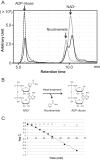
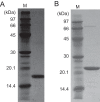

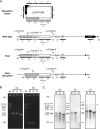
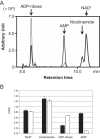

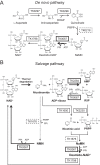
Similar articles
-
Hyperthermophilic Archaeon Thermococcus kodakarensis Utilizes a Four-Step Pathway for NAD+ Salvage through Nicotinamide Deamination.J Bacteriol. 2018 May 9;200(11):e00785-17. doi: 10.1128/JB.00785-17. Print 2018 Jun 1. J Bacteriol. 2018. PMID: 29555696 Free PMC article.
-
TK1211 Encodes an Amino Acid Racemase towards Leucine and Methionine in the Hyperthermophilic Archaeon Thermococcus kodakarensis.J Bacteriol. 2021 Mar 8;203(7):e00617-20. doi: 10.1128/JB.00617-20. Print 2021 Mar 8. J Bacteriol. 2021. PMID: 33468590 Free PMC article.
-
Identification of the glucosamine kinase in the chitinolytic pathway of Thermococcus kodakarensis.J Biosci Bioeng. 2018 Mar;125(3):320-326. doi: 10.1016/j.jbiosc.2017.10.005. Epub 2017 Nov 14. J Biosci Bioeng. 2018. PMID: 29146530
-
Role of NUDIX Hydrolases in NAD and ADP-Ribose Metabolism in Mammals.Biochemistry (Mosc). 2020 Aug;85(8):883-894. doi: 10.1134/S0006297920080040. Biochemistry (Mosc). 2020. PMID: 33045949 Review.
-
An overview of 25 years of research on Thermococcus kodakarensis, a genetically versatile model organism for archaeal research.Folia Microbiol (Praha). 2020 Feb;65(1):67-78. doi: 10.1007/s12223-019-00730-2. Epub 2019 Jul 8. Folia Microbiol (Praha). 2020. PMID: 31286382 Review.
Cited by
-
The Lreu_1276 protein from Limosilactobacillus reuteri represents a third family of dihydroneopterin triphosphate pyrophosphohydrolases in bacteria.Appl Environ Microbiol. 2024 Jul 24;90(7):e0081424. doi: 10.1128/aem.00814-24. Epub 2024 Jun 18. Appl Environ Microbiol. 2024. PMID: 38888337 Free PMC article.
-
Proteome-wide 3D structure prediction provides insights into the ancestral metabolism of ancient archaea and bacteria.Nat Commun. 2022 Dec 21;13(1):7861. doi: 10.1038/s41467-022-35523-8. Nat Commun. 2022. PMID: 36543797 Free PMC article.
-
Kynurenine pathway, NAD+ synthesis, and mitochondrial function: Targeting tryptophan metabolism to promote longevity and healthspan.Exp Gerontol. 2020 Apr;132:110841. doi: 10.1016/j.exger.2020.110841. Epub 2020 Jan 16. Exp Gerontol. 2020. PMID: 31954874 Free PMC article. Review.
-
Early Evolutionary Selection of NAD Biosynthesis Pathway in Bacteria.Metabolites. 2022 Jun 21;12(7):569. doi: 10.3390/metabo12070569. Metabolites. 2022. PMID: 35888693 Free PMC article.
-
Gamma radiation coupled ADP-ribosyl transferase activity of Pseudomonas aeruginosa PE24 moiety.Appl Microbiol Biotechnol. 2023 Mar;107(5-6):1765-1784. doi: 10.1007/s00253-023-12401-x. Epub 2023 Feb 18. Appl Microbiol Biotechnol. 2023. PMID: 36808279 Free PMC article.
References
Publication types
MeSH terms
Substances
LinkOut - more resources
Full Text Sources
Other Literature Sources

